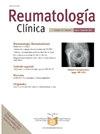Effect of Plasminogen Activator Inhibitor-1 on extracellular matrix homeostasis in scaffold-free spheroids from human chondrocytes
IF 1.2
Q4 RHEUMATOLOGY
引用次数: 0
Abstract
Introduction
New trends in osteoarthritis research focus on the use of biological therapy; in this context, the use of Plasminogen Activator Inhibitor-1 (PAI-1) is considered a potential therapeutic strategy to prevent extracellular matrix (ECM) degradation in osteoarthritis (OA) management. However, in vitro studies have not demonstrated its effect on the expression of ECM homeostasis-related genes.
Methods
Human OA cartilage-derived chondrocytes were used to generate scaffold-free spheroids under hypoxia conditions. The spheroids were exposed to PAI-1 for 24 h, and cell viability was measured. Then qRT-PCR was used to analyze the expression of ECM components and degradative enzymes, including COL2A1, SOX9, ACAN, COL1A1, MMP3, MMP9, MMP13, ADAMTS4, ADAMTS5, TIMP1, TIMP2, TIMP3, uPA and tPA.
Results
PAI-1 treatment consistently maintained cell viability and chondrocyte spheroid integrity. At the 50 ng/mL concentration, PAI-1 increased the gene expression of COL2A1 and reduced SOX9, ACAN, MMP3, MMP9, TIMP2, and tPA. Moreover, the functional COL2A1/COL1A1 ratio was significantly increased in PAI-1-treated spheroids.
Conclusion
Our results suggest that PAI-1 treatment exerts a complex and multifaceted influence on spheroids’ ECM. While it supports matrix integrity by reducing the gene expression of ECM remodeling enzymes, such as MMPs and ADAMTS5, it also induces unfavorable changes in chondrogenesis-related marker genes, such as SOX9 and ACAN. These findings indicate that the cellular response to PAI-1 is not unidirectional, warranting further investigation to understand its precise biological implications.
求助全文
约1分钟内获得全文
求助全文
来源期刊

Reumatologia Clinica
RHEUMATOLOGY-
CiteScore
2.40
自引率
6.70%
发文量
105
审稿时长
54 days
期刊介绍:
Una gran revista para cubrir eficazmente las necesidades de conocimientos en una patología de etiología, expresividad clínica y tratamiento tan amplios. Además es La Publicación Oficial de la Sociedad Española de Reumatología y del Colegio Mexicano de Reumatología y está incluida en los más prestigiosos índices de referencia en medicina.
 求助内容:
求助内容: 应助结果提醒方式:
应助结果提醒方式:


